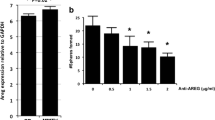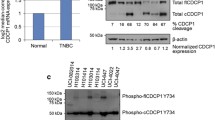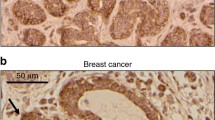Abstract
The final signal for triggering the formation of lamellipodia that initiate directional migration of mammalian cells is binding of the Wiskott–Aldrich syndrome (WASP)/WASP family verproline-homologous protein 2 (WAVE2) to the actin-related protein 2 and 3 (Arp2/3) complex. This WAVE2–Arp2/3 signal is suggested to be enhanced in some breast cancers, facilitating invasion, and/or metastasis. Here, we demonstrated one cause of the enhanced signal using four breast cancer cell lines (SKBR3, AU565, MCF7, and MDA-MB-231). The WAVE2–Arp2/3 signal was estimated semi-quantitatively by counting the number of lamellipodia expressing both WAVE2 and Arp2 using high-power confocal laser microscopy. Higher expression of the WAVE2–Arp2/3 signal was detected in SKBR3 and AU565, which have HER2 gene amplification, than in the other two cell lines that lack HER2 gene amplification. Trastuzumab suppressed both the formation of lamellipodia and migration in a Boyden chamber experiment in SKBR3 and AU565. When the HER2 gene was transfected into MCF7, the number of both lamellipodia and migrated cells was increased. This enhancement of migration did not occur in the presence of extracellular matrix, and zymographic analysis showed no clear difference between HER2 gene-transfected cells and MCF7 cells. Immunohistochemical analysis of 115 cases of breast cancer revealed that coexpression of WAVE2 and Arp2 was significantly correlated with HER2-overexpression (P < 0.0001). These data indicate that an abnormal signal resulting from HER2 gene amplification activates lamellipodia formation in breast cancer cells, which initiates their metalloproteinase-independent migration.







Similar content being viewed by others
References
Machesky LM (2008) Lamellipodia and filopodia in metastasis and invasion. FEBS Lett 582:2102–2111
Yamazaki D, Kurisu S, Takenawa T (2005) Regulation of cancer cell motility through actin organization. Cancer Sci 96:379–386
Machesky LM, Atkinson SJ, Ampe C et al (1994) Purification of a cortical complex containing two unconventional actins from Acanthamoeba by affinity chromatography on profilin–agarose. J Cell Biol 127:107–115
Welch MD, Iwamatsu A, Mitchison TJ (1997) Actin polymerization is induced by Arp2/3 protein complex at the surface of Listeria monocytogenes. Nature 385:265–269
Parolini O, Berardelli S, Riedl E et al (1997) Expression of Wiskott–Aldrich syndrome protein (WASP) gene during hematopoietic differentiation. Blood 90:70–75
Miki H, Miura K, Takenawa T (1996) N-WASP, a novel actin depolymerizing protein, regulates the cortical cytoskeletal rearrangement in a PIP2-dependent manner downstream of tyrosine kinases. EMBO J 15:5326–5335
Suetsugu S, Miki H, Takenawa T (1999) Identification of two human WAVE/SCAR homologues as general actin regulatory molecules which associate with the Arp2/3 complex. Biochem Biophys Res Commun 260:296–302
Mullins RD (2000) How WASP-family proteins and the Arp2/3 complex convert intracellular signals into cytoskeletal structures. Curr Opin Cell Biol 12:91–96
Takenawa T, Suetsugu S (2007) The WASP–WAVE protein network: connecting the membrane to the cytoskeleton. Nat Rev Mol Cell Biol 8:37–48
Mizutani K, Miki H, He H et al (2002) Essential role of Wiskott–Aldrich syndrome protein in podosome formation and degradation of extracellular matrix in src-transformed fibroblasts. Cancer Res 62:669–674
Rothschild BL, Shim AH, Ammer AG et al (2006) Cortactin overexpression regulates actin-related protein 2/3 complex activity, motility, and invasion in carcinomas with chromosome 11q13 amplification. Cancer Res 66:8017–8025
Yan C, Martinez-Quiles N, Eden S et al (2003) WAVE2 deficiency reveals distinct roles in embryogenesis and Rac-mediated actin-based motility. EMBO J 22:3602–3612
Suetsugu S, Yamazaki D, Kurisu S et al (2003) Differential roles of WAVE1 and WAVE2 in dorsal and peripheral ruffle formation for fibroblast cell migration. Dev Cell 5:595–609
Kurisu S, Suetsugu S, Yamazaki D et al (2005) Rac-WAVE2 signaling is involved in the invasive and metastatic phenotypes of murine melanoma cells. Oncogene 24:1309–1319
Yang LY, Tao YM, Ou DP et al (2006) Increased expression of Wiskott–Aldrich syndrome protein family verprolin-homologous protein 2 correlated with poor prognosis of hepatocellular carcinoma. Clin Cancer Res 12:5673–5679
Semba S, Iwaya K, Matsubayashi J et al (2006) Coexpression of actin-related protein 2 and Wiskott–Aldrich syndrome family verproline-homologous protein 2 in adenocarcinoma of the lung. Clin Cancer Res 12:2449–2454
Iwaya K, Oikawa K, Semba S et al (2007) Correlation between liver metastasis of the colocalization of actin-related protein 2 and 3 complex and WAVE2 in colorectal carcinoma. Cancer Sci 98:992–999
Iwaya K, Kohno N, Mukai K (2007) Coexpression of Arp2 and WAVE2 predicts poor outcome in invasive breast carcinoma. Mod Pathol 20:339–343
Condeelis JS, Wyckoff JB, Bailly M et al (2001) Lamellipodia in invasion. Semin Cancer Biol 11:119–128
Yuste L, Montero JC, Esparís-Ogando A et al (2005) Activation of ErbB2 by overexpression or by transmembrane neuregulin results in differential signaling and sensitivity to herceptin. Cancer Res 65:6801–6810
Iwaya K, Tsuda H, Fujita S et al (1995) Natural state of mutant p53 protein and heat shock protein 70 in breast cancer tissues. Lab Invest 72:707–714
Cheng GZ, Chan J, Wang Q et al (2007) Twist transcriptionally up-regulates AKT2 in breast cancer cells leading to increased migration, invasion, and resistance to paclitaxel. Cancer Res 67:1979–1987
Sossey-Alaoui K, Asfina A, Li X et al (2007) Down-regulation of WAVE3, a metastasis promoter gene, inhibits invasion and metastasis of breast cancer cells. Am J Pathol 170:2112–2121
Ueda Y, Wang S, Dumont N et al (2004) Overexpression of HER2 (erbB2) in human breast epithelial cells unmasks transforming growth factor ß induced cell motility. J Biol Chem 279:24505–24513
Yang C, Liu Y, Lemmon MA et al (2006) Essential role for Rac in heregulin ß1 mitogenic signaling: a mechanism that involves epithelial growth factor receptor and is independent of ErbB4. Mol Cell Biol 26:831–842
Oikawa T, Yamaguchi H, Itoh T et al (2004) PtdIns(3, 4, 5)P3 binding is necessary for WAVE2-induced formation of lamellipodia. Nat Cell Biol 6:420–426
Overall CM, Kleifeld O (2006) Validating matrix metalloproteinases as drug targets and anti-targets for cancer therapy. Nat Rev Cancer 6:227–239
Sahai E, Marshall CJ (2003) Differing models of tumor cell invasion have distinct requirements for Rho/ROCK signaling and extracellular proteolysis. Nat Cell Biol 5:711–719
Rose R, Weyand M, Lammers M (2005) Structural and mechanistic insights into the interaction between Rho and mammalian Dia. Nature 435:513–518
Acknowledgments
This study was supported in part by a Grant-in-Aid for Scientific Research (C) (Kakenhi 15590319). We thank Dr. Tadaomi Takenawa of Department of Lipid Biochemistry, Kobe University Graduate School of Medicine for helpful suggestions and discussion.
Author information
Authors and Affiliations
Corresponding author
Rights and permissions
About this article
Cite this article
Yokotsuka, M., Iwaya, K., Saito, T. et al. Overexpression of HER2 signaling to WAVE2–Arp2/3 complex activates MMP-independent migration in breast cancer. Breast Cancer Res Treat 126, 311–318 (2011). https://doi.org/10.1007/s10549-010-0896-x
Received:
Accepted:
Published:
Issue Date:
DOI: https://doi.org/10.1007/s10549-010-0896-x




